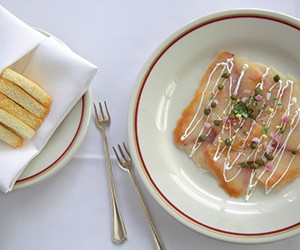The Gulf Coast states of Texas, Louisiana, Mississippi, Alabama and Florida have plenty to offer groups, including a temperate climate and distinct cultural and historical facilities. But they also feature their own specific iconic flavors that often incorporate fresh catches from the Gulf of Mexico with a traditional Southern spin.
To highlight the tastes of each region, Meetings Focus reached out to some local group dining spots and interviewed the chefs and owners who make the culinary magic happen.
Texas
Thoughts of smoked barbecue brisket or a certain favorite Tex-Mex dish probably come to mind when considering Texas cuisine, however, once you hit the coast things get a lot more complex.
In Houston, a more culturally diverse population broadens the food offerings available, from some of the best Vietnamese restaurants in the U.S. to authentic Mexican eateries. Get closer to the Gulf of Mexico and you will find some of the freshest seafood around.
Dining Highlight: Reef, Houston
Reef was named one of the best seafood restaurants in the U.S. by Bon Appetit magazine back in 2008, and since then chef and co-owner Bryan Caswell has continued to provide expertly prepared Gulf seafood to the Houston masses.
“Reef is more of a Gulf Coast restaurant than a Texas restaurant and it’s more of a Houston restaurant than it is a Texan restaurant,” Caswell says. “We have served over 87 different species out of the Gulf, which is a huge number, and with the exception of salmon, 100 percent of our finfish comes from 30 minutes to an hour from my backdoor.”
Growing up in southern Louisiana with a passion for fishing means Caswell knows his stuff when it comes to educating groups on different types of fish. Reef was also one of the first restaurants to fully embrace the sustainable seafood movement, which is an attempt to let certain types of fish rest by using lesser-known catches such as tripletail, sheepshead and triggerfish.
“We always called it trash fish and it was kind of a joke, but I ate all these things growing up and knew they were good,” Caswell says.
Reef features two private dining areas seating 60 and 16, respectively, but big tables can also be set up in the middle of the restaurant and the bar is large enough to support a sit-down event or stand-up cocktail party. Although the restaurant typically only entertains the idea of buyouts on Sundays, it does provide outside catering. PageBreak
Louisiana
Creole and Cajun cuisine is the iconic dish of choice in Louisiana, which blends a variety of European and African influences together in classic dishes such as gumbo and jambalaya.
No city better showcases this style of cuisine than The Big Easy itself, and groups will find a plethora of options for traditional eats in the area.
Dining Highlight: Arnaud’s, New Orleans
Located in the French Quarter of New Orleans—right off Bourbon Street—Arnaud’s is one of those legendary restaurants that tops foodie lists year after year. The family-owned restaurant started up in 1918 and has been cooking up classic Creole cuisine ever since.
“When I think of New Orleans cuisine in particular, fresh Gulf seafood comes to mind, specifically shrimp from the Barataria Bay, oysters from coastal Louisiana and crabs from Lake Pontchartrain,” says Tommy DiGiovanni, executive chef at Arnaud’s. “At this restaurant, we are able to serve as the vessel that carries these bountiful gifts to diners from near and far.”
Those “bountiful gifts” are included in such signature dishes as Shrimp Arnaud (shrimp in remoulade sauce), Smoked Pompano Bourgeois (hickory-smoked Gulf fish) and Oysters Bienville (shrimp, mushrooms and green onions in a white wine sauce). Chef DiGiovanni’s favorite is the first option.
“Fresh Gulf shrimp are the star of the dish, with Arnaud’s famous remoulade sauce playing a strong supporting actor role,” he says. “The recipe is top secret, but is considered the benchmark by which all other Creole remoulade sauces are measured.”
Arnaud’s can make special accommodations for larger-sized groups up to (and sometimes over) 900 guests with its 17 dining rooms spanning over 28,000 square feet.
Mississippi
Mississippi is divided up into five distinct regions–Delta, Hills, Pine, Capital River and Coastal–each with its own characteristic food traits. Examples include soul food, barbecue and home-cooked Southern meals. Once you hit the coast, a booming seafood industry presents itself with a mix of Croatian, Vietnamese and French influences.
Dining Highlight: Beau Rivage, Biloxi
The Beau Rivage Resort hosts an extensive line-up of restaurants, which all work to incorporate local Gulf Coast cuisine into their menus.
“We use ingredients that are indigenous of the region from Louisiana to Florida,” says Kristian Wade, executive sous chef at the Beau Rivage. “Seafood is of course what the coast is known for and we use it in all of our restaurants.”
He specified that Beau Rivage utilizes local shrimp, snapper, grouper, farm-raised catfish, crawfish, oysters and blue crabs in its menus.
“Like our surrounding area, Mississippi has a strong French and Spanish influence, and that remains a huge part of our cuisine,” Wade says.
Wade recommends Coast (pub-style appetizers and entrees), Stalla (Italian food), Jia (contemporary Asian cuisine) and BR Prime (signature steak and seafood) as the top on-site spots for parties of around 25 to 30 people, and he suggests using the catering service for larger groups. On-site catering can host dinners for as many as 1,200 and off-site options are also available. PageBreak
Alabama
Dining in the Heart of Dixie is often at its best when it sticks to the Southern classics of soul food, barbecue and seafood. Cities such as Birmingham and Huntsville will give attendees their fine dining fix, but if you want some of the best (and most recently caught) seafood you have to hit up the southern coast of the state. Enter the Gulf Shores and Orange Beach.
Dining Highlight: Cobalt, The Restaurant, Orange Beach
Cobalt, The Restaurant is located under the Perdido Bay Bridge next to its sister complex, Caribe The Resort, in Orange Beach, Ala., which lends itself to scenic waterfront views. The property even has boat slips available for small boats and medium-sized yachts.
“We sit right on Perdido Pass, which has a tidal flow in-and-out of the Gulf of Mexico,” says Brian Harsany, owner of Cobalt. “Our dining room faces the west, so every evening we get a fantastic sunset.”
For appetizers, some group favorites are the BBQ Shrimp (large Gulf shrimp sauteed in house-made New Orleans-style BBQ sauce) and Firecracker Shrimp (lightly fried tender bay shrimp, tossed in spicy remoulade sauce). Chargrilled oysters from the Gulf are another popular item.
If you’re looking for the full entree experience, the paneed grouper—Gulf of Mexico black grouper, paneed and served on sweet pea and asparagus risotto and topped with crab meat—is the most popular item on the menu, according to Harsany, who is no stranger to serving large crowds.
“We’ve done wedding parties of over 300 in the restaurant and our private dining room can do a seated dinner for up to 70, that’s just inside,” he says. “We have the capability of opening one door to the outside as well and catering facilities next door at Caribe.”
Harsany says the restaurant can work with groups to put together custom menus, beer and wine dinners, and cooking classes.
Florida
Florida’s cuisine is as diverse as its culture, but a strong Caribbean and Latin American flavor is at play in many of the state’s more original dishes. And of course seafood is the primary ingredient that binds this coastal state with its other Gulf Coast counterparts.
Dining Highlight: Epicurean, Tampa
Epicurean is taking the hotel dining experience to the next level by being one of the first culinary-themed boutique hotels on the market in Florida.
“We’ve positioned ourselves as a hotel built around a restaurant, and the concept has always been to focus on the food and provide a great place to stay afterwards,” says Brandon Marshall, director of sales at the Epicurean.
The 137-room hotel, which opened just last December after a “steak-cutting event” no less, is located in the historic Hyde Park neighborhood. Marshall says he believes people will travel to South Tampa for the sole purpose of staying at the Epicurean and tasting its diverse menu.
“Seafood is the obvious choice for local cuisine, but the fruits and vegetables here are also amazing,” says Chad Johnson, executive chef at Epicurean.
The hotel’s signature restaurant is Elevage, which puts a modern twist on classic dishes from around the world. There is a rooftop bar, called Edge, which will serve up an experimental cocktail menu, while Chocolate Pi is a patisserie specializing in handcrafted sweets.
As an added culinary bonus, the Epicurean’s management paired up with the legendary Bern’s Steak House to develop the hotel, and it is expected that guests will wander next door for a steak.
Finally, the Epicurean Theatre is likely to be a hit with groups who are looking to learn more about mixology and cooking techniques. Its classes are open to the public and Marshall mentioned he can use these educational sessions as a template for a team-building activity.







